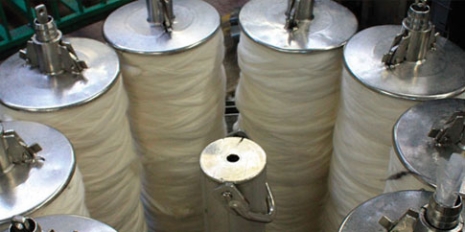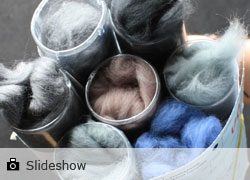
Wednesday, day three, and today we visited Lanificio Cerruti the high-end luxury Milan-based brand of clothing by Nino Cerruti (who trained Giorgio Armani).
Blog Part 5
Wednesday, day three, and today we visited Lanificio Cerruti the high-end luxury Milan-based brand of clothing by Nino Cerruti (who trained Giorgio Armani).
Lanificio Cerruti textile mill was established by Nino Cerruti’s grandfather in Biella in 1881. At the age of twenty, Nino became the head of the family woollen business and ventured into the production of clothing in the late 1950’s. Today Lanificio Cerruti manufactures approximately 3.5 million metres of fabric a year for the Cerruti brand (80% of production for men’s wear and 20% women’s wear), along with production for many other high end labels such as Boss, Armani, and Jean Paul Gaultier to name just a few.
 Cerruti only buy wool top (no greasy wool) which is combed in Biella so they can retain quality control. Generally they purchase ten types of tops for various yarn and fabric applications. In top form they are looking for micron, length and CVH to form the core woollen specifications and ideal typology of the wool. At Cerruti, understanding typology is very important because the company produces two collections (one for men and one for women in spring and summer). Each collection contains ninety articles, with eight designs per article and 35 colour variations per design. It’s interesting to note that 90% of the men’s collection was wool, which comprises almost 80% of their business.
Cerruti only buy wool top (no greasy wool) which is combed in Biella so they can retain quality control. Generally they purchase ten types of tops for various yarn and fabric applications. In top form they are looking for micron, length and CVH to form the core woollen specifications and ideal typology of the wool. At Cerruti, understanding typology is very important because the company produces two collections (one for men and one for women in spring and summer). Each collection contains ninety articles, with eight designs per article and 35 colour variations per design. It’s interesting to note that 90% of the men’s collection was wool, which comprises almost 80% of their business.
In regards to NZ Merino, Cerruti are generally using tops blended with 70% Australian Merino and 30% NZ Merino to provide the desired blend for their fabric collection. In the past they believe that top makers have been using NZ Merino to correct faults in Australian wool, yet they have found that NZ Merino is not as fine as Australian wool and if too much NZ Merino is used fabrics can feel too course (more than 20% of NZ wool makes a fabric too harsh – an optimum blend is 15%). The key aspects of NZ Merino valued by Cerruti are brightness and low VM.
We did talk about organics and traceability, and while traceability is a project they are working on, few customers are prepared to pay a premium for more ethical or environmentally sustainable fabrics at the present time.
Special thanks to Matto Cerruti for your time and insights. Grazie.
Comments
Post new comment